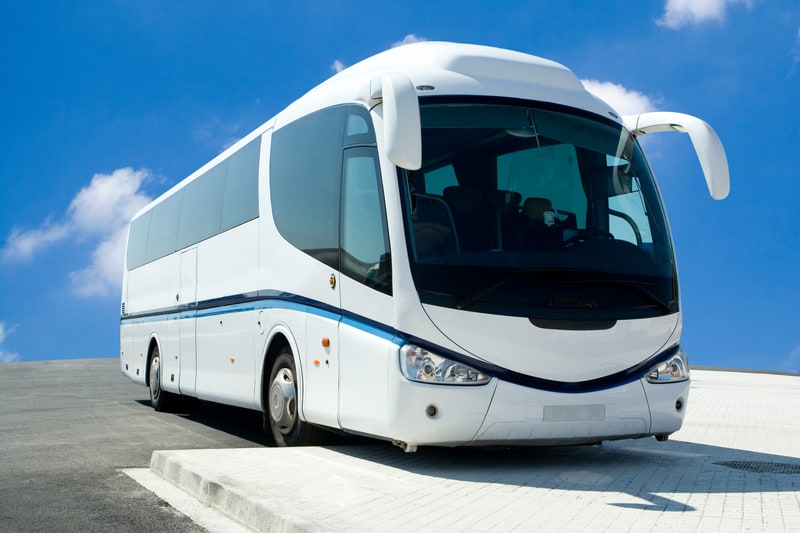
Buses are massive road vehicles that are mainly used for public transport. These vehicles are designed to accommodate many seats and are often bi-articulated or double-decker buses.
However, of all the buses in the world, which are the biggest? Let’s go through them!
Here are the 10 biggest buses in the world.
10. Setra BR Top Class 500 – 14.1m / 46ft
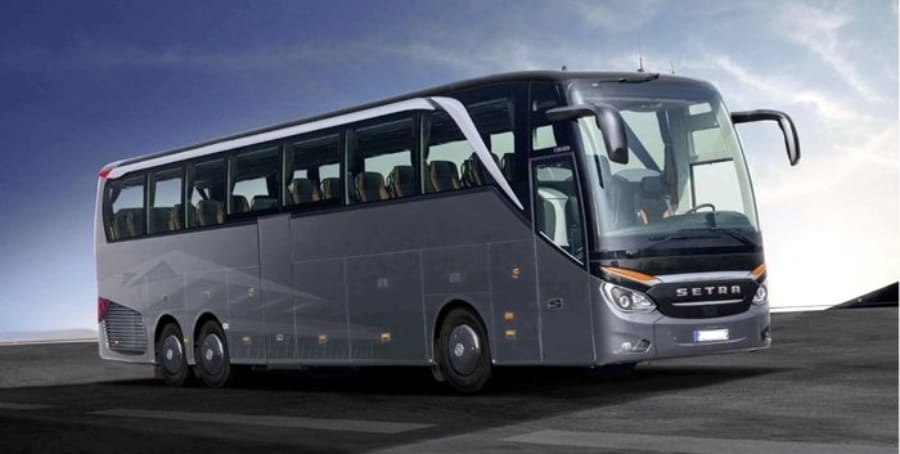
The Setra BR TC 500, with its timeless elegance, high quality, and luxurious amenities, is an ideal bus for long journeys and can seat 59 passengers. It is manufactured by the Setra bus company in Germany,
This coach is a high-performance 3-axle bus designed to provide maximum comfort and security. The bus has a spacious and luxurious interior with ample headroom.
It has multiple equipment and driver assistance systems, one of which helps the driver with speed and brake control.
The Setra BR TC 500 measures 14.1m in length, 2.5m in width, and has a height of 3.8 m. This bus has a 500-horsepower engine and a torque of 2500 newton meters.
Pros
- Spacious interior with a height of 3.8m
- Multiple equipment and driver assistance systems
Cons
- Only suitable for long distances
9. Volvo 9800 – 15m / 49ft

The Volvo 9800 is used on long-distance journeys and can accommodate 29 passengers, offering the best in comfort. It is manufactured by the Volvo company in Sweden.
This is a 3-axle bus that is designed to offer efficiency by having a maximum continuous run time and optimal fuel consumption. It has multiple driver assistance systems and an automatic vehicle height reduction function.
The Volvo 9800 bus is 15m long and 2.6m wide, and its weight is 24.7 tons. It has a 500-horsepower engine and a torque of 2500 newton meters.
Pros
- Efficient run time and optimal fuel consumption
- Automatic vehicle height reduction
Cons
- Low seating capacity
8. Marco Polo Paradiso New G7 1800 DD – 15m / 49ft
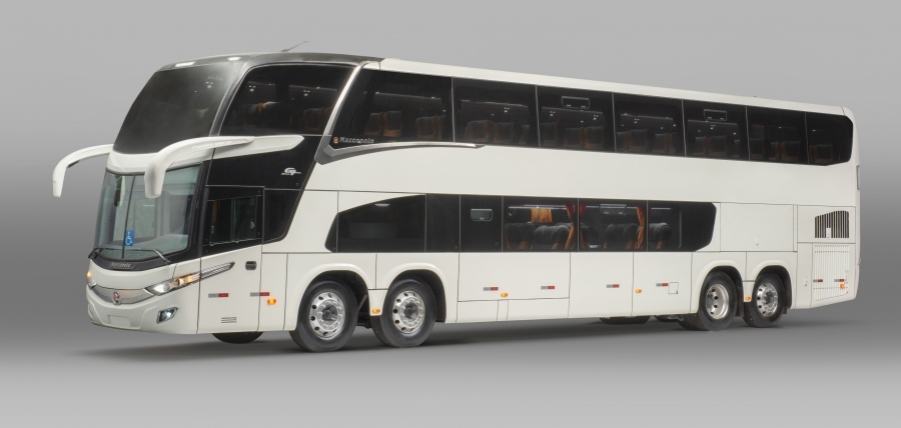
The Marco Polo Paradiso New G7 1800 DD is used on medium and long-distance routes and has space for a total of 64 passengers. This bus is manufactured by the Marco Polo group in Brazil.
This double-decker bus is designed with a high level of sophistication to deliver the highest level of safety.
The passenger seats offer a high level of comfort and equipment, with some seats that provide a fully reclining position. The lower floor seating area can be changed into a lounge. The huge windows offer excellent views, and there is a particular seat and lift for wheelchairs.
The bus is 15m long, 2.6m wide, and has a height of 4.1m. It has 440 horsepower and a torque of 1550 newton meters. This bus is powered by a K-series Scania engine. The fuel tank has a capacity of 600 liters, and the bus can reach a speed of 120kph.
Pros
- High level of safety and luxuriously comfortable
- Reaches speeds of 120 kph
Cons
- Route restrictions due to height
7. Mercedes-Benz O530 Citaro C2 Hybrid – 19m / 62ft
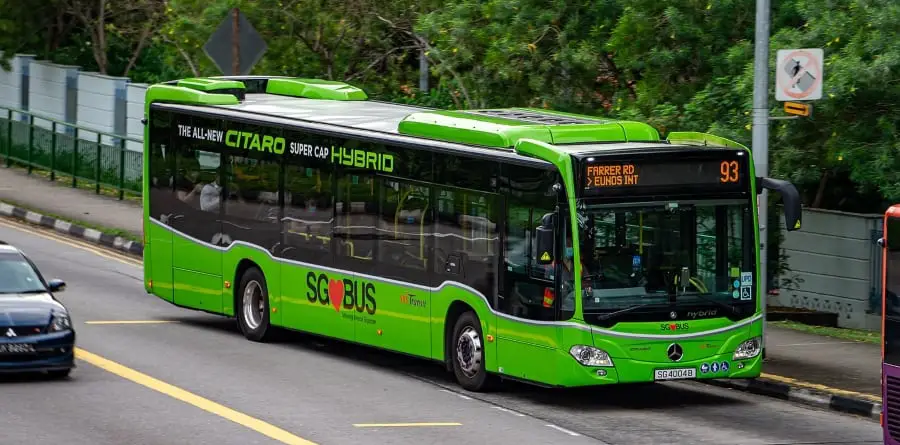
This large bus can accommodate 93 people, plus 2 wheelchair bays. The bus was designed and built by Mercedes Benz and EvoBus GmbH and is used on regular service bus routes in urban cities.
It is a low-floor twin-axle bus with a Mercedes-Benz OM 936 engine. This bus is 19.5m in length and 2.55m in width, with a height of 3.1m. The engine has 220 kW and 1,200 newton meters.
The motor output is 15 kW with a maximum of 220-newton meters. The diesel engine is paired with supercapacitors for reduced fuel consumption.
The driver’s seat of the Mercedes-Benz O530 Citaro C2 Hybrid is comfortable, with ergonomically arranged controls and numerous assistance systems to assist the driver. Videos are installed onboard to monitor passenger safety. The passenger seats are comfortable, with generous headroom space.
Pros
- Diesel engine paired with supercapacitors for reduced fuel consumption
- Comfortable passenger seats and lots of headroom
Cons
- Small electrical motor
6. Akia Ultra IF-25 – 25m / 82ft
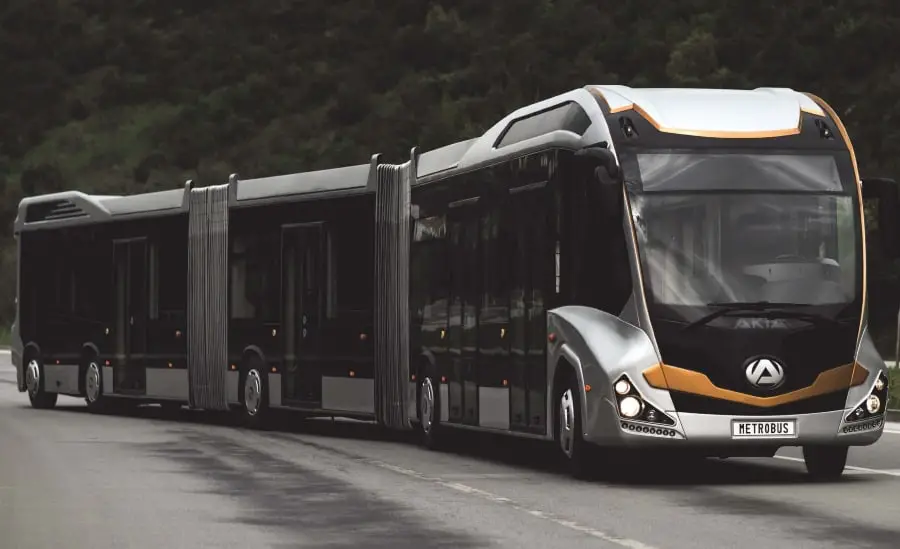
The Akia Ultra IF-25 can seat a total of 290 passengers, and at present, this bus is being used as a transit bus in countries such as Turkey. The bus is manufactured by the Akia company in Turkey.
It is a 5-axle bi-articulated bus with a Euro 6 Mercedes engine. It was designed to provide safety, maneuverability, and a high load capacity. It has many security features and a total of 8 side doors on both sides of the bus.
The Akia Ultra IF-25 bus measures 25m in length, 2.5m in width, and has a height of 3.4m. It has a 456-horsepower engine and a torque of 2200 newton meters.
Pros
- Features many security measures
- Several passenger access points
Cons
- Only being used in Turkey
5. BYD K-12A – 27m / 88ft
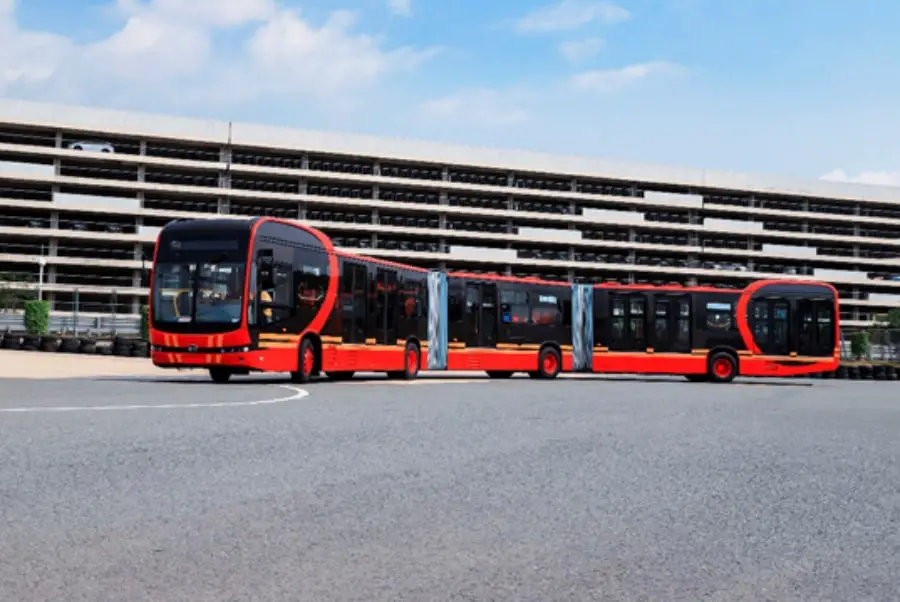
This electric bus can accommodate 250 passengers and is used as a transit bus. The BYD K -12A is manufactured in China by the BYD company.
This 4-axle electric bi-articulated bus is designed to function as a rapid transit bus. It has two traction modes (2WD and 4WD) which enable the bus to circulate on different types of terrain.
The BYD K-12A measures 27m in length and is currently the longest electric bus in the world. It can reach a maximum speed of 70kph and has a range of 300km. This bus is equipped with 2 drive axles of 800 horsepower in total. The bus can be charged via AC or DC, allowing more options for charging.
Pros
- 2 traction modes to circulate different types of terrain
- 2 drive axles with 800 horsepower in total
Cons
- Short-range, more frequent charging is required
4. Volvo B340M – 28m / 92ft
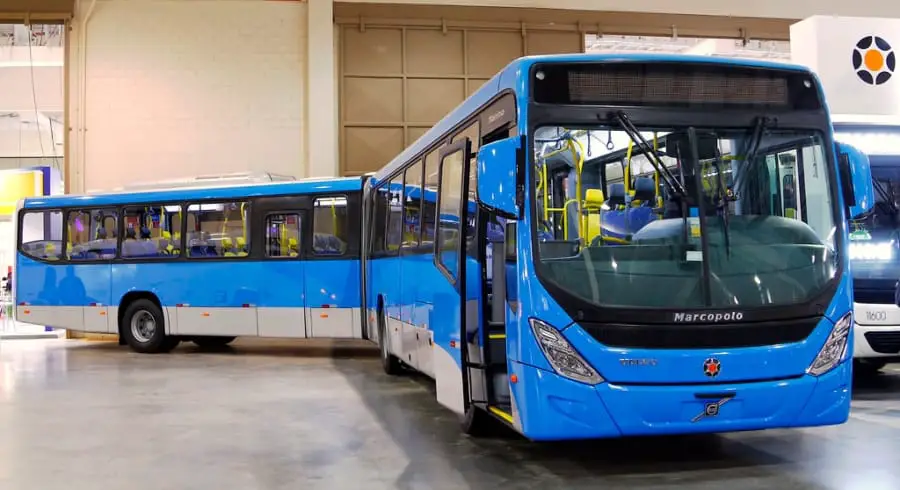
The Volvo B340M is used as a transit bus in countries like Brazil, and it has space for 300 passengers. It is manufactured in Sweden by the Volvo company.
This vehicle is a 4-axle bi-articulated bus with a Volvo DH12E 6-cylinder in-line diesel engine. It has a speed limit of 60 kph and is fitted with 2 fuel tanks that hold 540 liters of fuel.
The Volvo B340M measures 28m in length and is 2.4m wide. It is fitted with a 340-horsepower engine and has a torque of 1700 newton meters. It has an automatic control system that, together with a GPS, identifies risk areas and reduces speed.
Pros
- Fitted with 2 tanks to hold 540 liters of fuel
- Automatic control system and GPS identifies risk area and reduces speed
Cons
- Low top speed
3. Scania F360 HA – 28m / 92ft
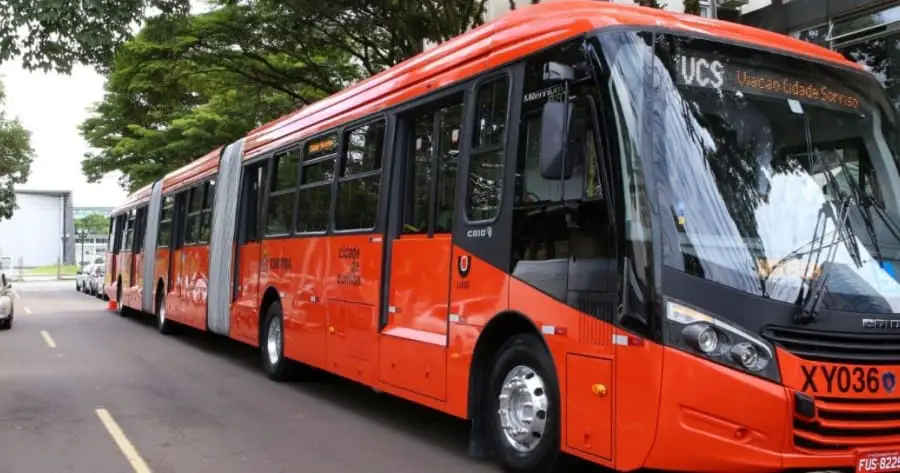
This enormous bus can accommodate 280 passengers and is used as a rapid transit bus in Brazil. It is manufactured in Sweden by the Scania company.
The Scania F360 HA is a 4-axle bi-articulated bus with a Scania DC13 engine. It was constructed for its reliability and ability to remain stable when cruising at speeds of 70 kph. The engine is designed to run at low revs to improve fuel consumption and keep running costs down.
The bus measures 28m in length and 2.6m in width. It is powered by a 360-horsepower engine and has a torque of 1850 newton meters.
Pros
- The engine runs at low revs to improve fuel consumption
- Built for reliability and stability when cruising at 70 kph
Cons
- Low power engine
2. Marcopolo Viale BRT – 28.5m / 93ft
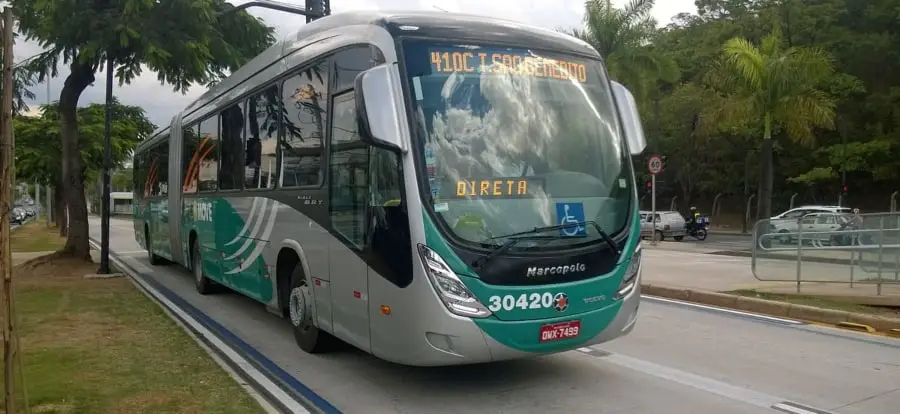
This bus is designed to seat 230 passengers in reasonable comfort. It is currently being used for rapid transport in Brazil and Guatemala. The Marco Polo Viale BRT is made in Brazil by the Marco Polo company and produced at their Columbian plant.
The bus is a 4-axle bi-articulated vehicle and is designed to be strong and reliable. The Viale BRT is built on a Volvo chassis and specifically constructed to deliver safety and efficiency to all passengers using the rapid transit system.
This bus measures 28.5m in length and has a width of 2.6m. It has an engine that delivers 340 horsepower and a torque of 1700 newton meters. To increase passenger safety, the Viale BRT has been fitted with an array of internal and external cameras.
Pros
- Strong and reliable
- Fitted with cameras, inside and outside, for added passenger safety
Cons
- Currently only available in South America
1. Autotram Extra Grand – 30.7m / 100ft
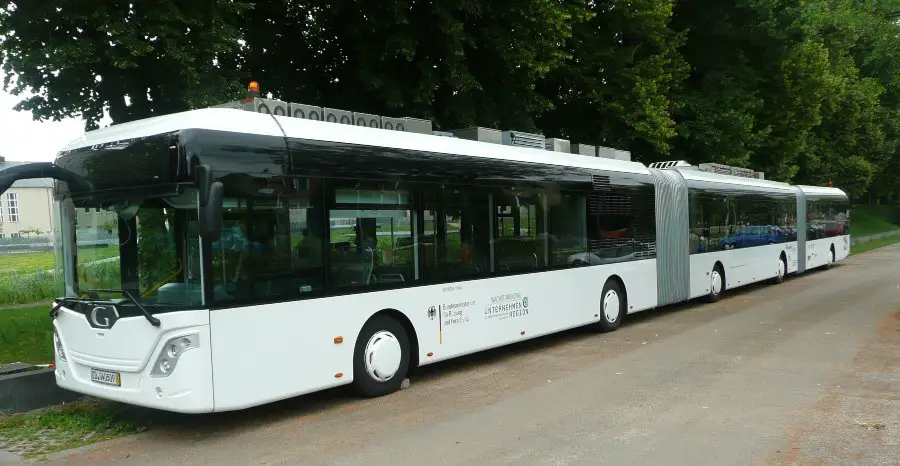
This is the largest of all buses, and it is used for urban transport in large cities. The Autotram Extra Grand can comfortably seat 256 passengers in total and is manufactured in Germany by the Göppel bus company.
The Autotram is a 5-axle hybrid bi-articulated bus. It is a low environmental impact design but still has a great transport capacity.
It has well-thought-out driver assistant systems, such as a video and DGPS, which are responsible for guiding the vehicle. The video recognizes bus stops and supports the driver in a bi-directional mode.
The bus is 30.7m in length, with a width of 2.5m and a height of 3.4m. While the average bus has 220-450 horsepower, this bus comes with a 610-horsepower engine supplied by Iveco Fiat engines, and the bus weighs a whopping 27 tons. The Autotram Extra Grand is fitted with advanced power steering technology making it easy to maneuver.
The electric energy is generated by a diesel-electric power pack, and the batteries can be recharged while the bus moves. The batteries can also be recharged at charging stations. In full-electric mode, the bus has a range of 2km.
Pros
- It is a hybrid that has less impact on the environment
- Batteries can be recharged during driving
Cons
- Range only 2km on battery
- Only used for urban transport
